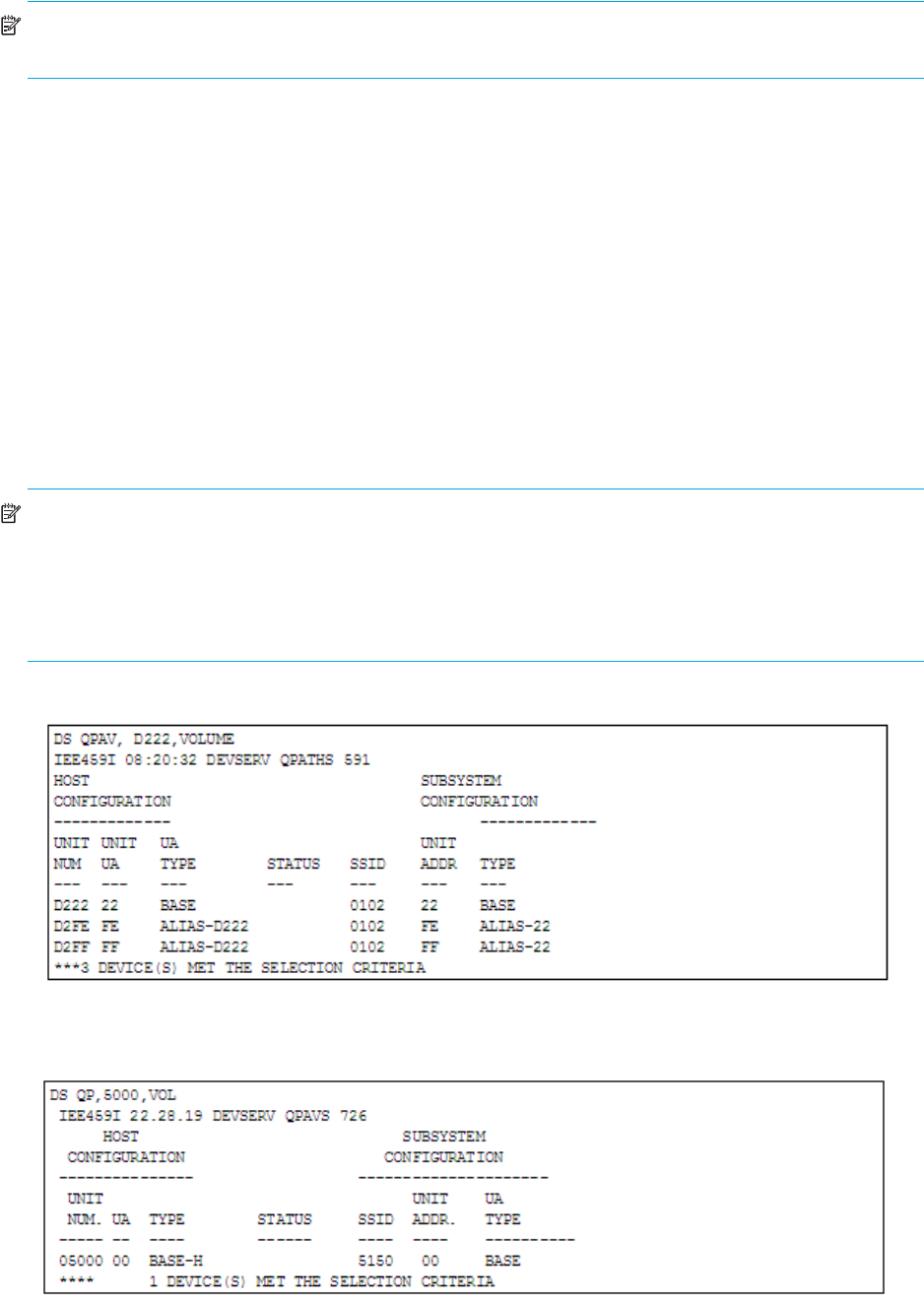Hitachi HPAV for z/OS user guide (HITA737-96006, June 2008)
Table Of Contents
- Contents
- Compatible PAV Function for the XP1024/XP128/XP12000/XP10000
- Overview of Compatible PAV Operations
- Preparing for Compatible PAV Operations
- Performing Compatible PAV Operations
- Monitoring Compatible PAV Activities
- Additional MVS Commands
- GTF I/O Tracing
- Figure 13 Sample Output of Display Command - Compatible PAV Base Device with 5 Aliases
- Figure 14 Sample Output of Display Command - Compatible Hyper PAV with 16 Aliases
- Figure 15 DEVSERV DISPLAY PATHS Command
- Figure 16 Sample DEVSERV QPAV Command (Compatible PAV)
- Figure 17 Sample DEVSERV QPAV Command (Compatible Hyper PAV)
- Figure 18 Sample Output of DEVSERV QPAV,SSID=xxxx Command (Compatible PAV)
- Figure 19 Sample Output of DEVSERV QPAV,SSID=xxxx Command (Compatible Hyper PAV)
- Figure 20 Sample Output of DS QP,xxxx,VOLUME Command (Compatible PAV)
- Figure 21 Sample Output of DS QP,xxxx,VOLUME Command (Compatible Hyper PAV)
- Figure 22 Sample Output of D IOS,HYPERPAV Command
- Using HCD to Define and View XP1024/XP128/XP12000/XP10000 LCUs and Compatible PAV Devices
- Using HCD to Define an XP1024/XP12000/XP10000 LCU and the Base and Alias Devices
- Figure 23 Basic HCD Panel
- Figure 24 Define, Modify, Or View Configuration Data
- Figure 25 Add Control Unit Panel
- Figure 26 Selecting the Operating System
- Figure 27 Select, Change Option
- Figure 28 Control Unit Chpid, CUADD, and Device Address Range Addressing
- Figure 29 Define, Modify, Or View Configuration Data
- Figure 30 I/O Device List
- Figure 31 Add Device
- Figure 32 Device / Processor Definition Panel - Selecting the Processor ID
- Figure 33 Define Device / Processor Panel
- Figure 34 Define Device to OS Configuration Window - Selecting the OS Configuration
- Figure 35 Select / Disconnect Option
- Figure 36 Define Device Parameters / Features
- Displaying Compatible PAV Device Parameters
- Using HCD to Define an XP1024/XP12000/XP10000 LCU and the Base and Alias Devices
- Checking the WLM PAV Settings
- Settings about Compatible Hyper PAV
- Index

HPAV for z/OS user guide for the XP128/XP1024/XP12000/XP10000 31
NOTE: When each base device is assumed to be assigned the same number of aliases, the
recommended ratio of base devices to aliases is 1:3.
Verifying Base and Alias Device Definition
After defining the mapping between base devices and alias devices to the host operating system (see
”Definition of XP1024/XP128/XP12000/XP10000 Base and Alias Devices” on page 30), verify that the
host recognizes the XP1024/XP128/XP12000/XP10000 devices as specified.
To verify that the host system recognizes the settings for the XP1024/XP128/XP12000/XP10000 base and
alias devices:
1. At the MVS console display information about the base devices and the corresponding alias addresses
using the DEVSERV (DS) command. See Figure 10 on page 31.
DS QPAV, XXXX,VOLUME (XXXX = address of the base device)
On the OS using Compatible Hyper PAV, the relation between base devises and alias devises is not
fixed. Therefore, the information about the base devices only is displayed.
2. Verify that the information displayed by the DS command matches your definitions of base devices and
alias addresses.
NOTE: The information displayed by the DS command should match the Compatible PAV settings that you
specified at the Command View management station or XP Remote Web Console for base devices and
alias addresses. If it does not match, redefinition is required. After dynamic Compatible PAV has been
used, the information may not match, but the mismatch will not cause any problems. For dynamic
Compatible PAV, the mismatch occurs because the host system can change the number of aliases assigned
to each base device.
Figure 10 Verifying the Base Devices and Alias Addresses (Compatible PAV)
Figure 11 Verifying the Base Devices (Compatible Hyper PAV)










